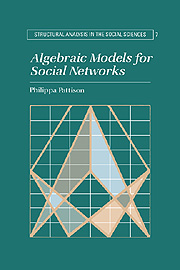Crossref Citations
This Book has been
cited by the following publications. This list is generated based on data provided by Crossref.
Barnes, George R.
Cerrito, Patricia B.
and
Levi, Inessa
1996.
Algebraic structure of the interaction semigroup as related to the homogeneity of network.
The Journal of Mathematical Sociology,
Vol. 21,
Issue. 4,
p.
295.
Batchelder, William H.
Kumbasar, Ece
and
Boyd, John P.
1997.
Consensus analysis of three‐way social network data.
The Journal of Mathematical Sociology,
Vol. 22,
Issue. 1,
p.
29.
Ruef, Martin
1997.
Prolegomenon to the relation between social theory and method*.
The Journal of Mathematical Sociology,
Vol. 22,
Issue. 3,
p.
303.
Barnes, George R.
Cerrito, Patricia B.
and
Levi, Inessa
1998.
A mathematical model for interpersonal relationships in social networks.
Social Networks,
Vol. 20,
Issue. 2,
p.
179.
Anderson, Carolyn J
Wasserman, Stanley
and
Crouch, Bradley
1999.
A p* primer: logit models for social networks.
Social Networks,
Vol. 21,
Issue. 1,
p.
37.
de Nooy, Wouter
1999.
The sign of affection.
Social Networks,
Vol. 21,
Issue. 3,
p.
269.
McKelvey, Bill
1999.
Avoiding Complexity Catastrophe in Coevolutionary Pockets: Strategies for Rugged Landscapes.
Organization Science,
Vol. 10,
Issue. 3,
p.
294.
Lazega, Emmanuel
and
Pattison, Philippa E
1999.
Multiplexity, generalized exchange and cooperation in organizations: a case study.
Social Networks,
Vol. 21,
Issue. 1,
p.
67.
Boyd, John P.
and
Everett, Martin G.
1999.
Relations, residuals, regular interiors, and relative regular equivalence.
Social Networks,
Vol. 21,
Issue. 2,
p.
147.
Bowyer, R.S.
and
Bogner, R.E.
1999.
Cooperative behaviour in multi-sensor systems.
Vol. 2,
Issue. ,
p.
807.
Sempé, Laurent
2000.
Une échelle de mesure de l'appartenance aux cercles sociaux : Analyse factorielle confirmatoire multiniveaux.
Recherche et Applications en Marketing (French Edition),
Vol. 15,
Issue. 2,
p.
43.
Montgomery, James D.
2000.
8. The Self as a Fuzzy Set of Roles, Role Theory as a Fuzzy System.
Sociological Methodology,
Vol. 30,
Issue. 1,
p.
261.
Borgatti, Stephen P
and
Everett, Martin G
2000.
Models of core/periphery structures.
Social Networks,
Vol. 21,
Issue. 4,
p.
375.
Michell, Joel
2001.
Teaching and misteaching measurement in psychology.
Australian Psychologist,
Vol. 36,
Issue. 3,
p.
211.
Barnes, G.R.
Cerrito, P.B.
and
Levi, I.
2001.
Weighted interaction semigroups.
The Journal of Mathematical Sociology,
Vol. 25,
Issue. 2,
p.
139.
Boyd, John P.
and
Jonas, Kai J.
2001.
Are social equivalences ever regular?.
Social Networks,
Vol. 23,
Issue. 2,
p.
87.
Pattison, Philippa E.
and
Breiger, Ronald L.
2002.
Lattices and dimensional representations: matrix decompositions and ordering structures.
Social Networks,
Vol. 24,
Issue. 4,
p.
423.
Marx, Maarten
and
Masuch, Michael
2003.
Regular equivalence and dynamic logic.
Social Networks,
Vol. 25,
Issue. 1,
p.
51.
Barnes, George R
Cerrito, Patricia B
and
Levi, Inessa
2003.
Construction of well separated interaction semigroups to refine the modeling of social networks.
Social Networks,
Vol. 25,
Issue. 2,
p.
161.
Han, Shin-Kap
2003.
Tribal regimes in academia: a comparative analysis of market structure across disciplines.
Social Networks,
Vol. 25,
Issue. 3,
p.
251.



